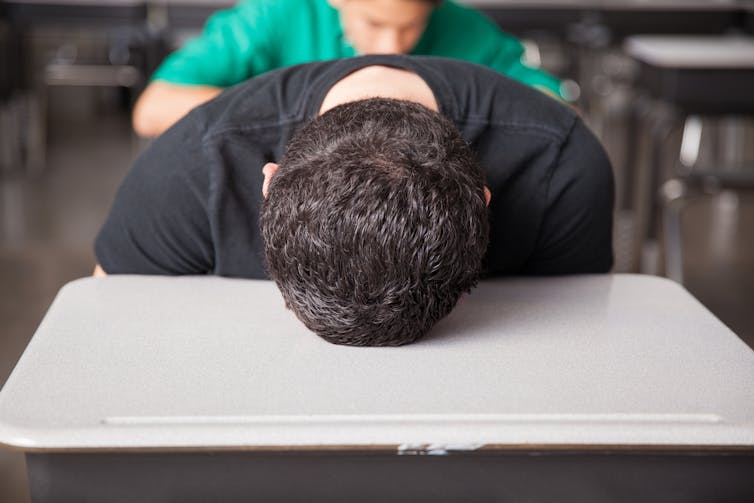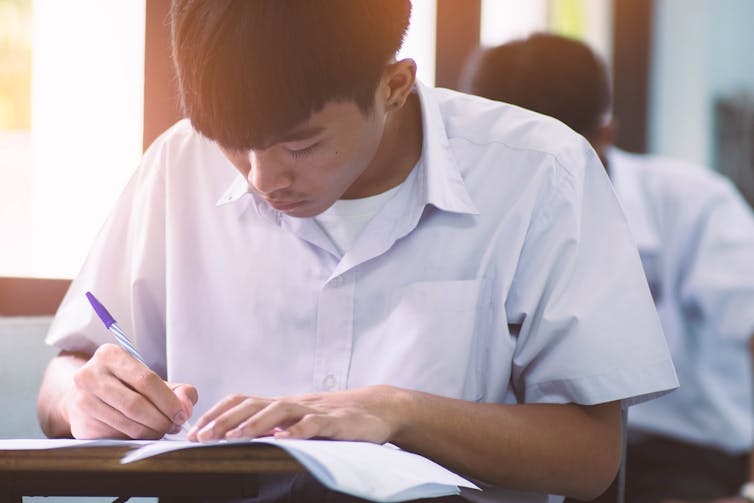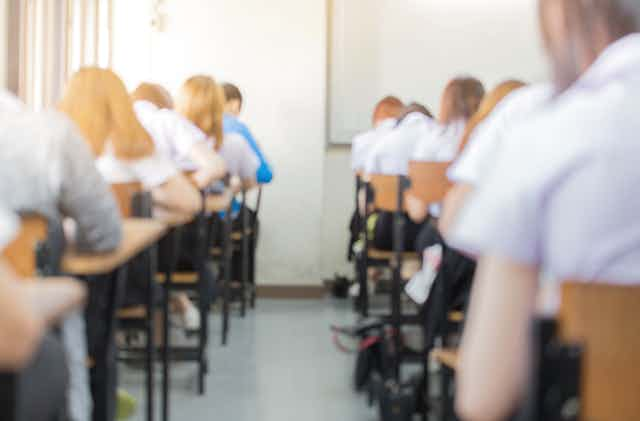Each year in Victoria, thousands of students disengage from school between the start of Year 9 and the end of Year 12.
Many are expelled or suspended. Others simply switch off in class, skip lessons, or quit school to seek out different educational and training pathways.
Whatever the reason, many high school teachers say something significant happens to school engagement levels around Year 9.
My research, which involved working with Year 9 teachers in Victorian high schools, seeks to better understand what’s happening with student disengagement in this year level – and what can be done to change it.
Lost, disengaged and ‘in never-never land’
Year 9 (when a child typically turns 14 or 15) is a challenging year for a teenager, in part due to the maelstrom of puberty and adolescence. One Year 9 teacher told me students at this age see themselves
as that in-between stage. ‘Am I a child? Am I an adult? What if I’m neither?’
Students at this age often strongly feel they no longer fit in. These age appropriate but intense levels of introspection can make some students look at the repetitive and seemingly endless cycles of school tasks, tests and homework and wonder, “what’s the point?” As one research paper puts it:
In Australia, Year 9 is widely seen as a problem, a time when young people disengage from school; and when curriculum and student identity often fail to cohere with each other.
Year 9 teachers described this year to me as “the lost year”, where students often drift off to “never-never land”. One even said it was traditionally seen as “a waste of a year”.
This suggests an opportunity for schools to design their Year 9 curriculum to help these students see the relevance of school.

Specialist Year 9 programs
Some schools have implemented specialist programs for Year 9. Some have large-scale residential programs, where students live and learn away from home for extended periods. Other programs focus on students learning about and through their local communities.
In Ballarat, where I am based, about half the high schools have a substantial Year 9 program. The structure varies. Sometimes it’s just a one-day-a-week program combining in-school and out-of-school learning experiences. Other programs are conducted entirely offsite over the course of a term.
One case study I explored was a Year 9 program at a school in regional Victoria. About 70% of students at this school fall in the bottom and bottom-middle quartiles of the Australian distribution of socio-economic advantage.
In my paper, I gave this program (which the school developed) the pseudonym “Renewal”. In Renewal, several learning areas (English, health and humanities) are taught together by a single teacher. Students are in the program for six out of 20 periods per week.
Having one teacher assigned to each class for the entire Renewal program allows them to build rapport and connection. As one teacher told us:
Students have come to me, their Renewal teacher, before they’ve gone to their tutorial teacher, before they’ve gone to their house leader, and said: ‘I’m feeling extremely overwhelmed, I’m having anxiety problems, I don’t know why, it’s freaking me out.’
Another told me the program allows students “to explore, investigate, ask questions about life issues that they wouldn’t normally ask a teacher.”
This rapport better positions the teacher to handle tricky issues with absenteeism, bullying and self-harm than teachers who see them less frequently.

A different approach
Renewal combines classroom-based activities with camps, excursions, guest speakers and other specialist programmes. One exercise, for example, involves dropping the students off in the local town centre, where they have to complete a series of tasks on a trail.
In the Renewal program, the careers unit and mock job interviews are done at the start of the year to support students to get part-time employment.
Students are given more agency than a traditional approach would allow. School work might be done, for example, via essay-writing, painting, drawing, in the form of a radio interview or other formats.
As one teacher told me:
The kids have more opportunity in regards to choosing their own destination […] to be able to find their own learning.
One teacher described a task where students write “a persuasive letter to the council […] about a health issue in the community, that they wanted funding for.”
Another relayed how outdoor tasks “fires up a different part of their brain”, saying:
One of the teachers created this map where they had to go around and imagine if they were to sleep rough where they could sleep.
Teachers themselves also learn from the Renewal program. One said:
I’m much more flexible. It’s probably something I should be focusing on, to bring into my other classes. Just allow a bit more time for things.
Resonating with students’ lives
Schools with specific approaches to Year 9 are hearing positive responses from students via surveys and other feedback. One teacher from the Renewal program even noticed how:
Getting up, in front of the class and presenting is a big deal for a lot of people […] I find with Renewal it’s easier for me to get people up than it is [even] for my Year 11 class.
The success of Year 9 programs hinges on a tailored curriculum that resonates with students’ lives, taught by teachers dedicated to fostering strong connections.

